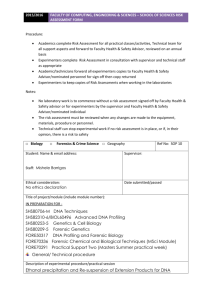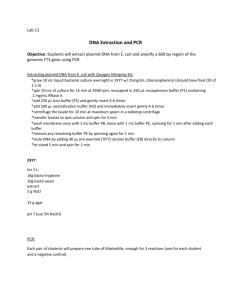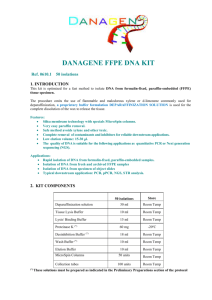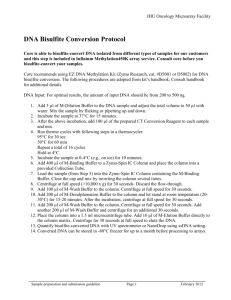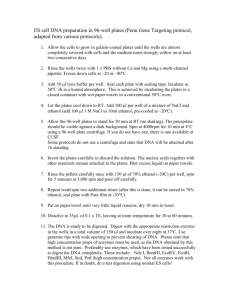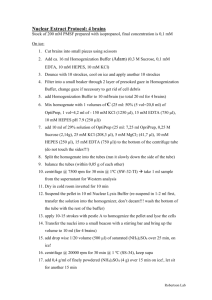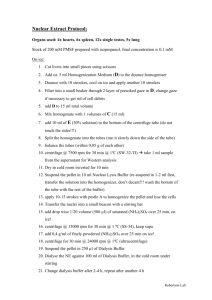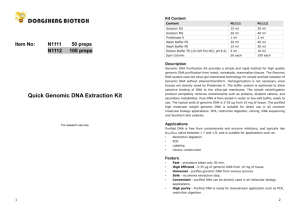SOP 11 Micro extract buccal
advertisement
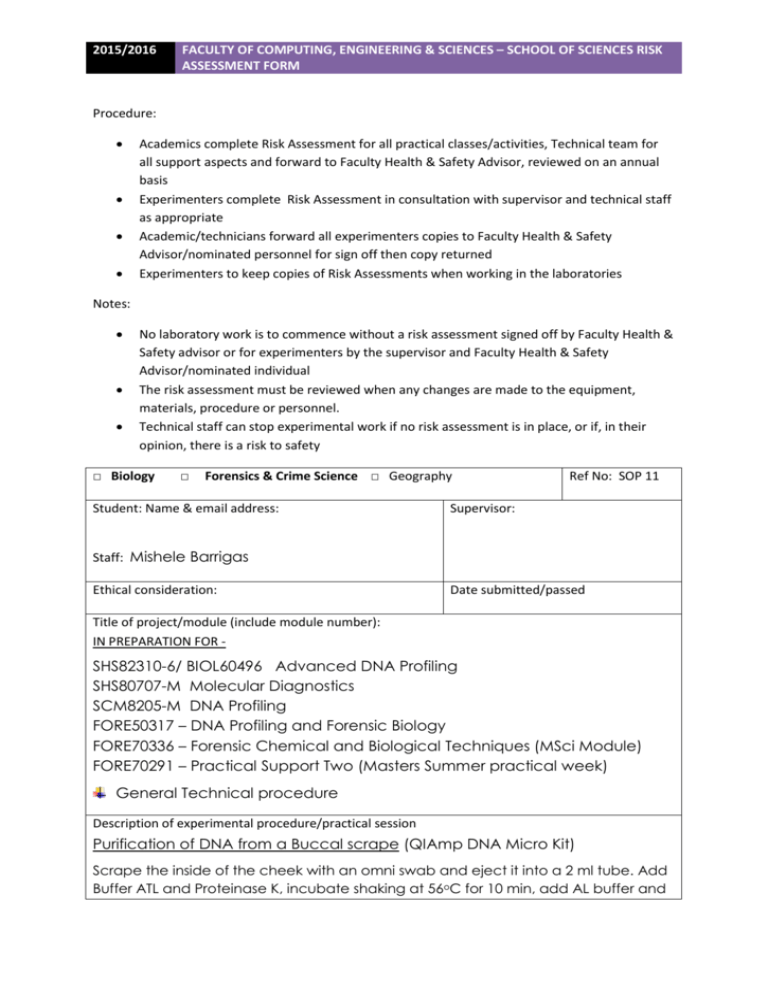
2015/2016 FACULTY OF COMPUTING, ENGINEERING & SCIENCES – SCHOOL OF SCIENCES RISK ASSESSMENT FORM Procedure: Academics complete Risk Assessment for all practical classes/activities, Technical team for all support aspects and forward to Faculty Health & Safety Advisor, reviewed on an annual basis Experimenters complete Risk Assessment in consultation with supervisor and technical staff as appropriate Academic/technicians forward all experimenters copies to Faculty Health & Safety Advisor/nominated personnel for sign off then copy returned Experimenters to keep copies of Risk Assessments when working in the laboratories Notes: No laboratory work is to commence without a risk assessment signed off by Faculty Health & Safety advisor or for experimenters by the supervisor and Faculty Health & Safety Advisor/nominated individual The risk assessment must be reviewed when any changes are made to the equipment, materials, procedure or personnel. Technical staff can stop experimental work if no risk assessment is in place, or if, in their opinion, there is a risk to safety □ Biology □ Forensics & Crime Science □ Geography Student: Name & email address: Ref No: SOP 11 Supervisor: Staff: Mishele Barrigas Ethical consideration: Date submitted/passed Title of project/module (include module number): IN PREPARATION FOR - SHS82310-6/ BIOL60496 Advanced DNA Profiling SHS80707-M Molecular Diagnostics SCM8205-M DNA Profiling FORE50317 – DNA Profiling and Forensic Biology FORE70336 – Forensic Chemical and Biological Techniques (MSci Module) FORE70291 – Practical Support Two (Masters Summer practical week) General Technical procedure Description of experimental procedure/practical session Purification of DNA from a Buccal scrape (QIAmp DNA Micro Kit) Scrape the inside of the cheek with an omni swab and eject it into a 2 ml tube. Add Buffer ATL and Proteinase K, incubate shaking at 56oC for 10 min, add AL buffer and re-incubate, shaking, at 70oC for 10 min. Add Ethanol vortex and centrifuge. Transfer lysate to the spin column, centrifuge, discard flow through and repeat. Add AW1 buffer, centrifuge, discard flow through and add AW2 buffer, centrifuge and discard flow through. Recentrifuge to dry membrane before adding PCR water, incubate at RT for 1 minute before centrifugation for 1 minute. Transfer entire contents of flow through to a sterile 1.5 ml tube. Hazards inherent in the work, record details and possibility of harm: (equipment, procedures, invertebrate /environmental samples, body fluids) Record precautions which will be taken: (e.g. Any standard operating procedures to follow, SAF codes, faculty policies) Electrical hazards: Vortex, microcentrifuge, heating block. Ensure all equipment has been electrically tested and has passed, before use. Buffers AL and AW1 contain guanidine hydrochloride, which can form highly reactive compounds when combined with bleach. During extraction procedure no bleach or acidic reagents allowed near the area or during clean up. All reagents are used in small volumes. COSSH assessment (harmful substances) Minimum handling precautions Toxicity data: Hazardous to the aquatic environment Acute toxicity Gases under pressure Corrosive Explosive Flammable Caution Oxidising Longer term health hazards Fume cupboard (F) Safety glasses (SG) Microbiological cabinet (Cab) Laminar flow cabinets (LF) Gloves (GL) Face mask (M) Respirator (R) Other All INFOMRATION CAN BE FOUND ON MSDS (MATERIAL SAFETY DATA SHEETS) ON THE INTERNET OR SCIENCES CHEMICAL DATABASE ON-LINE OR WITHIN EACH OF THE LABORATORIES Chemicals involved (including Products): Toxicity data as above: Minimum handling precautions: Quantity to be used: ml/g/% solution Fl, C C Gl Gl 500 µl 600 µl C Gl 600 µl Per sample Buffer AW2 (70% ethanol) Buffer AL (+ guanidinium chloride) Buffer ATL (+SDS + edetic acid) Buffer AW1 (+guanidine 2 hydrochloride) (56% ethanol) Proteinase K 100% Ethanol PCRWater Fl, C C C, Fl C, Gl Gl Gl Gl Microorganisms: Classification: Minimum handling precautions: Do any of the above substances have a workplace exposure limit (WEL) please state value and precautions: OES 1000ppm/8Hr TWA (ethanol) 600 µl 20 µl 300 µl 50-150 µl Yes No Disposal information (How will all reactants/products be disposed of?) All waste lysate to be dispensed, during procedure, into a dedicated and correctly labelled bottle. This bottle is to be treated as clinical waste (autoclaved in a red hazard bag before storing in the clinical waste bin for collection by a dedicated company). Pipette tips, tubes etc are disposed of in clinical waste cartons, autoclaved and stored for collection, as above. Have you checked all reactants are not hazardous to the environment? YES Any special conditions specified as part of the permission to carry out the work/procedure and actions needed to minimise risk e.g. adherence to HTA or body fluid policy 1.52, completion of fieldwork risk assessment etc. Informed consent and declaration forms to be completed by any persons performing this procedure on their DNA * . These forms are retained by the technical manager. Adherence to Human tissue act must be followed. Human body fluid policy 1.52 to be adhered too. Supervisor/Academic comments: (Any disability issues to be aware of?) Staff/Supervisor - What level of risk do you assign with this work? High Medium Low Date: 2 September. 2015 Faculty H&S approval Date of Review Date: September 2016 3 4
